To run the forums, host the website, and travel, I charge a universal service fee for my reviews. This review was sponsored by Xtracycle. My goal is to be transparent and unbiased, this video and written review are not meant to be an endorsement of Xtracycle products.
Xtracycle has updated their cargo bikes and I was happy to get a chance to check out the Edgerunner eSwoop. The eSwoop is a long-tailed cargo bike named so after the low step-through frame it utilizes. The bike comes in multiple sizes, but each size features the same full steel frame with a rigid steel fork offering a lot of strength. The frame has nice double tubing with these cross members adding extra frame support and really reduces frame flex, so your cargo doesn’t feel tippy (although there is a bit due to the length of the frame). As I mentioned before, the frame is the same size overall, what changes in the bike sizes is the stem and seat post. The bike comes in Black or this Ocean Blue with White and Red accents. The cost starts at $4697 and the one we tested here is $6922 which includes a couple of extra accessories and 2 Bosch PowerPack 500 batteries. Similarly, the bike weighs 62lbs, ours tested here tipped the scales at 87lbs. I am sure the batteries had a bit to do with that as each weight 5.7lbs as well as the optional Bosch CX motor (which is not only the highest power motor, but the heaviest at 8.8lbs). Customers can also opt for the Bosch Performance Line Speed, a great motor if you are looking for a similar system that has a higher max speed. The Bosch systems are among some of my favorite, offering technology that not only keeps things smooth, but reliable as well. For the tires, Xtracycle equipped the Edgerunner with a set of reflective (although the back reflection can be a bit covered by the bags) Schwalbe Big Ben Balloon tires with puncture protection, a great higher volume option for comfort. The wheel in the front is 26”x21.5” with a bit shorter spokes making it a bit stronger. I love the 15mm through axle with quick release up front which is also stiffer and stronger. Helping to keep a low center of gravity is a smaller rear wheel (20”x2.5”) which keeps the weight at the bottom and makes things easier to load. Another great feature is the battery integrated Herman’s lights. The headlight in the front is positioned out of the way (if your front cargo load isn’t too high) and has these awesome side windows that let light peek out of the corners making for more visibility with your surroundings. Another Herman’s light in way in the back, also positioned in at great place, staying out of the way of most cargo loads. Working my way around the bike, I see this 31.6mm seat post which gets the job done, but I recommend swapping it out for a suspension seat post if you plan on doing some of the long-term riding that is usually associated with cargo bikes. The cockpit features swept back aluminum alloy bars with locking ergonomic grips and the one we tested had 3 separate 30mm spacers for the stem. Overall, it’s very approachable without sacrificing versatility and attention to detail. It can handle 400lbs total, has lots of mounting points, a Yepp! seat window, and has one of the best turning radiuses I have ever seen on a long-tailed cargo bike! I mean, this thing has really been purpose built, and as such, really feels like a modular system. There are just so many options here, like these sling style or standard style pannier bags, hooptie box with finger guards, 2 different battery and motor options, optional running boards, front and rear rack, fender mounts in the front, and bottle cage bosses. Even more accessories can be found listed in the bike details on this page as well as their website. It’s one of the stronger and more durable cargo bikes I’ve seen, offering more mass and more momentum with that longer wheelbase. Other features include a walk mode, deflopilator, wider and larger plastic pedals, and a double leg kickstand positioned further back to eliminate pedal lock.
Driving this electric bicycle is a trail optimized mid-motor from Bosch called the Performance Line CX. It’s rated up to 75 newton meters, considerably more than the standard Performance Line and Performance Line Speed, which peak at 63nm. Given the slightly heavier footprint of this bike and possibility of carrying extra cargo, it’s a great choice. Part of me feels that the motor is overkill for this application, and it probably inflates the price a bit, but you do benefit from a special eMTB drive mode that only the Bosch CX offers. In this mode, which is the third step up just before Turbo, the motor performance can operate from 120% to 300% based on how hard you push. The other modes (Eco, Tour, and Turbo) have more limited power bands. This drive mode was introduced as a way to make motor performance more automatic and intuitive for mountain bikers who might be focusing on trail obstacles and gear shifting. For the Edgerunner and its 10-speed shifting, although it is not designed for trail riding, eMTB mode is just one more way that the bike can be ridden without distraction or thought. Just hop on, arrow up to eMTB, start pedaling, and the bike will respond naturally based on how hard you pedal. All current generation Bosch Performance Line motors weigh roughly 8.8lbs, which is more than Shimano, Yamaha, or Brose drive units. The CX produces more noise, especially in high power and a higher pedal speeds, and it also uses more energy… but it’s known for being reliable and having a good network of certified repair shops. This motor responds based on three signals: rear wheel speed, pedal cadence, and pedal torque. It uses some of the most advanced sensors and can even sense when gears are being shifted. Even though you can shift while the motor is operating, I find that it’s more efficient and physically easier to do when you ease off a bit. Aside from increased noise and weight, the one other trade-off with Performance Line drive units from Bosch is that they utilize a reduction gearing system that adds some pedal drag. This only happens when the motor is turned off or you attempt to pedal beyond the maximum supported speed (20mph 32km/h, or 25km/h in some markets). It’s not enough to ruin the experience but keep this in mind when test riding at dealers. Mechanically, the Edgerunner features a 10 speed Shimano Deore derailleur with a 11-42 teeh sprocket and handlebar mounted trigger shifters on the right (two-way high, three-shift low) with a windowed gear display. Coupled with that is the Shimano Deore two-finger brake levers controlling the 180mm dual piston hydraulic brake rotors. Overall this is a great setup and I really appreciate having that kind of power and stopping ability when hauling cargo.
Powering the motor, integrated lights, and backlit display panel, is one or two 482.4watt hour battery packs from Bosch. The battery, a PowerPack 500, fits low, in a frame housing behind the seat post and near the motor. If you want two batteries, it will cost a bit extra, so do be aware of that. Extra Bosch batteries are not cheap, but it could be worth it for heavier riders, those hauling cargo or passengers, and those who might be commuting longer distances. You can charge either pack off of the bike frame or plug into one location to fill both packs in series while mounted to the bike. It’s worth noting that the packs charge and deplete at an even level on each battery, rather than using up one then the other. This helps maintain the life of the batteries as well. Lithium-ion cells, including the 18650 cells used in both of these packs, tend to be very reliable if you maintain them at 20% to 80% capacity when not in use and store in a cool dry environment vs. extreme heat or cold. I frequently store my electric bike indoors because it isn’t as heavy or smelly as a moped or motorcycle, and this keeps it clean and safe while also protecting the battery from extreme temperatures. Charging happens quickly here, thanks to the included 4amp Bosch charger, yet it’s relatively compact and lightweight compared to others on the market. Bosch does sell an even smaller, lighter charger, that delivers 2 amps. They call this the travel charger and I read many comments from people who use it at a work site or carry it along in a backpack or pannier. In closing, the PowerPack weighs less than the PowerTube at 5.7lbs vs. 6.3lbs, but you’ll want to make extra sure to hear it click into place on the frame when mounting before rides. If you have an older PowerPack 400, it will work with the same interface as the PowerPack 500, so you can swap packs or rent and borrow if you travel frequently.
Once you’ve charged and secured the battery pack, operating the bike is pretty straight forward. The control panel consists of a grayscale LCD with four surrounding buttons. The power button is built into the top edge, a + and – button is reachable along the left front portion, and a walk mode button is built into the lower edge. Pressing the power button brings the LCD to life quickly, and a faint white glow is always active, making it readable in low lighting conditions. I’ve created an in-depth guide to the Bosch Purion display panel, with video overview, in the EBR forums here. It’s not removable however, and the Micro-USB port on the right edge is not active for charging as is the case with the larger Bosch Intuvia or new Kiox (which Xtracycle says they will be offering as paid upgrade). I much prefer the Intuvia for its size and additional menus (shift recommendation, clock, max speed, average speed, and trip time), and some shops can upgrade you to this display for ~$200 if you don’t go with the Kiox at time of purchase. With Purion, you’ve got a streamlined and simple interface with the necessities including trip distance, total distance, and range estimate. You can cycle through these menus by holding the – key, and you can reset trip distance by holding – and + simultaneously for a couple of seconds. The main portion of the display is used to show your current speed and assist level. If you’d like to change units from miles to kilometers, you simply hold – and tap the power button. Anytime you change from one assist level to the next, the menu briefly changes. In my experience, the buttons don’t click in as consistent as Intuvia, and there’s no dedicated light button (hold + to activate the lights if you’ve got the CX motor), but it gets the job done. If this was the only display that Bosch produced, I might be a little more enthusiastic about it here, it is a great display, I think I’ve just grown to appreciate the charging, removability, color, and Bluetooth features on some of their nicer displays. Most of the mountain models I review here do spec Purion, to hide and protect the display. For me, it would have been worth an additional $50 or $100 in the price tag given how expensive the bike already is, but it’s not a deal killer by any means.
I really like the Xtracycle Edgerunner eSwoop and it’s great to see a company stick to something and continually improve it. Although cargo bikes are known for their practicality, they are also known for being a bit cumbersome and awkward for some general uses. For the Edgerunner, you may notice rear bags can get in the way of reflective tires, or that a tall enough front bag could block the view of the integrated headlight. And even though the bike has this double tubing with cross members, it does have a little bit of frame flex that I tried to show in the review video. I love that the batteries keep the weight low and centered but having the two can make it tricky to get them in and out. I did also want to mention the ride can be a bit floaty for some, mostly due to the longer wheel base. And one more thing to mention is some of the exposed wires which, on the one hand may not be your preference, but on the other hand makes it easy for dealers to service the bike as well as keep the service cost down on your end. But I guess these are some of the tradeoffs to consider for getting all this practicality and versatility that the Edgerunner offers. It truly is a smooth and efficient cargo bike with an impressive set of options and uses and I really love the tight turning radius I show in the video, it comes in so handy! Thank you Xtracycle for giving me the chance to check out the new Edgerunner eSwoop.
As always, I welcome questions and feedback in the comment section below. Whether you own a previous version of the bike, have taken a test ride, or are brand new to the space, my goal is to provide an objective and honest resource. You can also join the Xtracycle Ebike forums and share your own photos, videos, and review updates to help others! Have fun out there, and ride safe :)
Pros:
- Comes in a number of configurations including the ability to choose the Bosch CX motor or the Bosch Speed motor
- Each size features a full steel frame with a rigid steel fork offering a lot of strength, double tubing, and cross members so your cargo doesn’t feel tippy
- Uses the Bosch battery system which allows for swapping out other battery models (like the PowerPack 400) and even has an option to run off of two batteries, great for extending range on long cargo trips when you have other things to worry about
- Has included reflective sidewall puncture protective high volume Schwalbe Big Ben tires
- The rear tire is smaller for keeping the weight low and centered as well as being very approachable for loading in the rear
- Has a great turning radius, makes U-turns easy on even normal sized sidewalks
- I love the battery integrated front and rear Herman’s lights, great placement for visibility, the headlight even has a couple of side windows that light can peek out of for extra visibility
- The swept back bars with ergonomic grips have a great feel of for comfort and good riding geometry
- A versatile system with a wealth of accessories available to fit almost any use, some of my favorites are the Hooptie rear bar box, Yepp! kids seat, and running boards called U-Tubes
- The Bosch CX system is at home here being both powerful and smooth, I think the Bosch Speed system option would be great too
- Having a Bosch system with a 10-speed Shimano Deore works really well in sync, I love the trigger shifters as well, it adds to the experience and makes for a great ride
- Hydraulic brakes are very welcome in any cargo bike and I appreciate the Shimano Deore 180mm disc setup utilized here
- The 4amp Bosch battery charger is one of my favorites and charges batteries quickly, if you want a smaller one Bosch also has a 2amp charger that I hear travels really well
- Xtracycle is offering a value-version of their Edgerunner for 2019 that uses a smaller PowerPack 400 and Performance Line motor vs. the PowerPack 500 and CX (so it provides 63nm of torque vs. up to 75nm) for $4,497
Cons:
- The ride to some may feel a little ‘floaty’ given the longer wheelbase
- There are a few external wires, which may seem like a bad thing, but it is not all that bad considering this means the dealers can service the bike much faster, saving them time and you money
- The headlight in the front is great for visibility, especially with the side windows that let light peek out, be careful because of the position not to block it with a tall bag or other cargo
- If you have the Hooptie accessory, be mindful that the batteries may be difficult to lock and unlock as well as remove
- By default, it seems that if you have rear bags attached, they can get in the way of that reflective tire stripe on the rear tire, a bummer if you are going for more visibility… however, Xtracycle has created an optional $20 bag cover “lid” that adds back the visibility if you have bags
- The longer wheelbase also provides a bit of frame flex, I try to show it in the video if you want to see it up close
- The Bosch CX motor is great but can produce a little bit of pedal drag from the reduction gearing system
- The company offers frame ‘sizes’ but my understanding is that they are essentially the same frame with adjustments made to the stem and seat post, make sure to find the right fit
- The Purion display does its job well, but I think I may have been spoiled with other displays like the Kiox and the Intuvia, these make the Purion feel a little more basic… but at least there are upgrade paths available from Xtracycle and dealers
- Fender mounts are here, but none included unfortunately, make sure to add your own if as many cargo bike users ride in the rain or shine
- A lot of other cargo bikes are starting use utilize belt drives or CVP shifting to increase smoothness, this is something the Edgerunner has yet to incorporate, however the Shimano system does very well here
Resources:
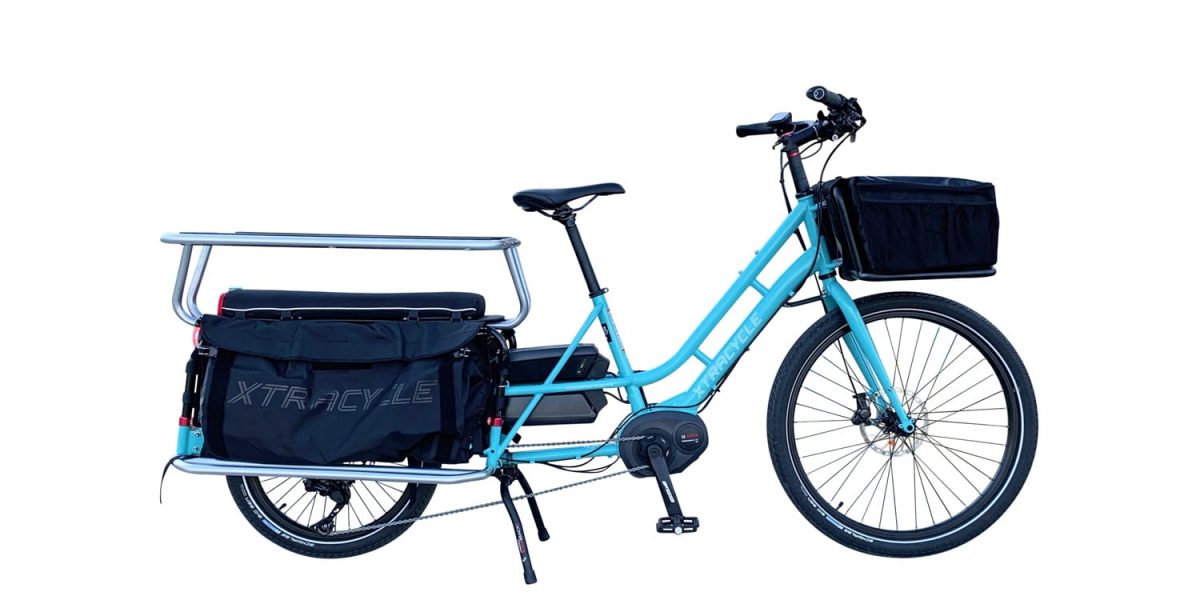















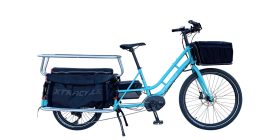

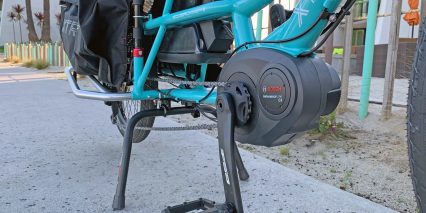

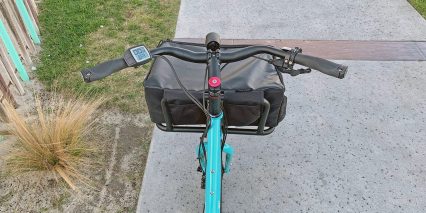
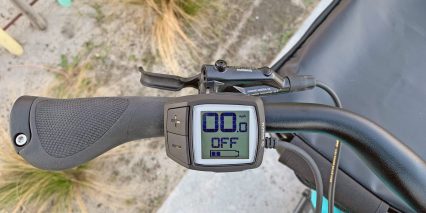
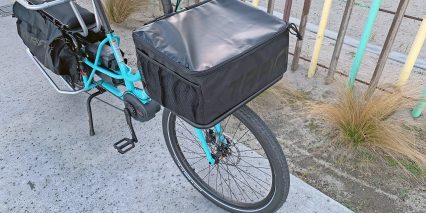
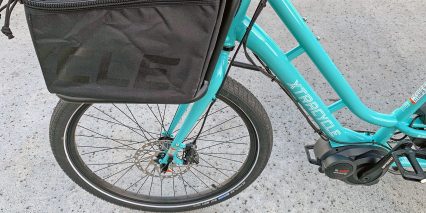

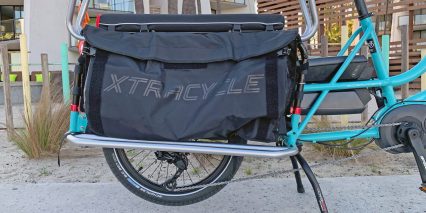
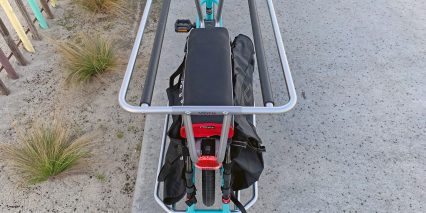
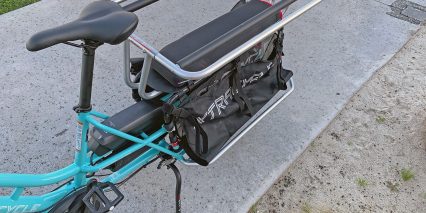
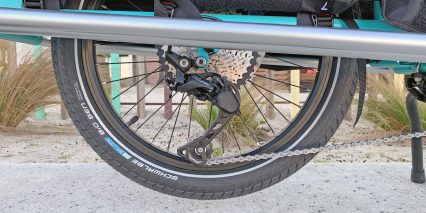
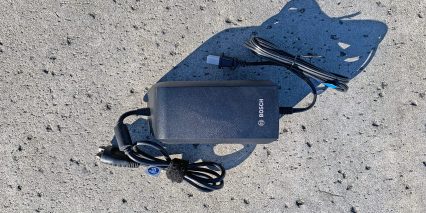
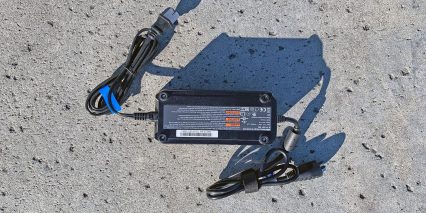
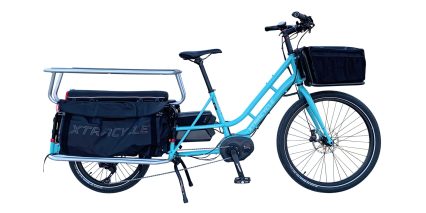

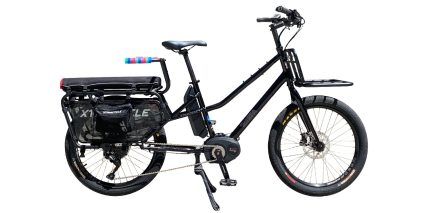

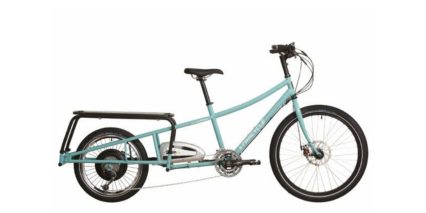
Richard
6 years agoThe wheel in the front is 26”x21.5” 2.15″?
ReplyCourt
6 years agoNot exactly, it’s like the front wheel is 26″ x 2.15″ and the back wheel is 20″ x 2.15″. Sorry if that was a little confusing :)
Reply